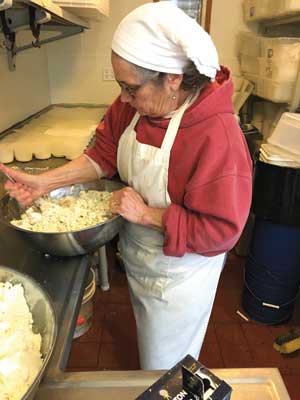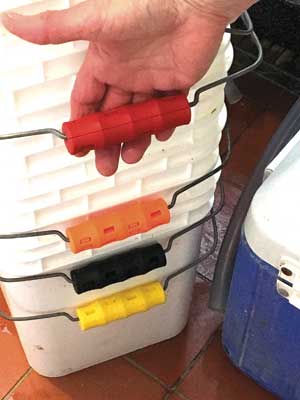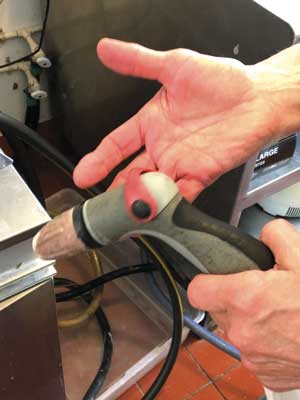 |
| Nearly every cheesemaking task requires strong hands and shoulders. The work surface height is important for musculoskeletal health. Alternate standing with sitting on a stool to reduce leg fatigue and lower back stress. The important thing is to be able to work without stooping. |
 |
| Larger handles protect finger joints and cartilage from stress. |
 |
| A fireman’s nozzle reduces hand stress. |
By Ellen S. Gibson
Photos by the author
Maine AgrAbility works with Maine farmers who struggle to continue their work due to injury, illness or disability. The USDA-funded program is a partnership between the University of Maine Cooperative Extension, Alpha One Independent Living Center, and Goodwill of Northern New England. Each partner brings its expertise and institutional insights to the challenges at the intersection of farming, health and employment.
To become an AgrAbility client, an intake form is completed, and then an on-farm visit is conducted. A “kitchen table interview” helps us understand the context and issues that need to be addressed – level of pain, work routines, limitations and the farmer’s goals. This service is free.
On the day I visited Appleton Creamery at the end of March, mud was beginning to ooze underfoot and an icy fog hung in the air. About half of Caitlin Hunter’s herd of 60 Alpine, Saanan, Totenburg, Nubian and Nigerian crosses had kidded that week. The sun-warmed room where the kids are housed was full of laughter and exuberance as they climbed all over the volunteers who had come to help with feeding.
Hunter has been making cheese for 37 years. With an impressive list of awards for her varietal cheeses behind her and a busy season ahead, she contacted AgrAbility for help in addressing the pain she experiences in her hands and shoulders.
For years Hunter was a self-described “one-woman show” as shepherd, milkmaid and cheesemaker. A leading voice in the local food movement, she is the founding president of the Maine Cheese Guild. Reflecting on the evolution of her business, Hunter says, “I made cheese back in the early ‘80s when you could still do it with a home food processor’s license.” After she moved to Appleton in 1986, the regulations changed. To be licensed in 1992, she had to build a dairy from the ground up. “Our first season we milked 12 goats and attended two farmers’ markets. This last season, we milked 60 and attended five farmers’ markets.” In addition she maintains several wholesale accounts, adds her cheeses to four CSAs and has a small on-farm store.
How Does She Do It All?
Her daughter, Fiona, now 28, was a big help on the farm and at the farmers’ markets when she was growing up. “She’s off doing her own thing now,” says Hunter. Her husband, Brad, provides background support and does all the cooking.
Hunter began to work with MOFGA apprentices when demands of the business and challenges of the physical work had become more than she could handle. The work requires two apprentices per season. With apprentices Hunter has added an important educational component to her work, passing her knowledge on to the next generation.
“These days,” she says, “as part of my role as a teacher of new cheesemakers, I also advise them to think ahead 30 or 40 years to when they can’t lift and move as easily. I hate seeing beautiful new cheese rooms that are well designed and efficient, but [the producers] still have to hand carry buckets of whey out to the pigs or whatever.”
Daily Routine of Making Cheese
From mid-March, when the goats begin to kid, until Christmas, Hunter makes cheese every day. She processes about 300 gallons of milk per week. That’s roughly 43 gallons a day, or 344 pounds of milk, that will be lifted to be strained. The milk is carried by hand to the cheese room where it is lifted into the pasteurizer. After pasteurization, it is drained into 5-gallon buckets, carried within the cheese room to where it will be processed, and lifted again.
Every 10 gallons of milk generates about 9 gallons of whey. At Appleton Creamery a gravity-feed pipe moves whey out of the cheese room to a stock tank for the goats to drink. Other cheesemakers use a pump.
The lifting, carrying, draining and pouring happen multiple times throughout the day. This is exactly the kind of repetitive work that wears out joints, stresses the surrounding cartilage, tendons and muscles and leads to arthritis.
AgrAbility On-Farm Assessment
Ketra Crosson, a registered occupational therapist (OT) on the AgrAbility staff, went on-farm to view Hunter’s work from an OT perspective. Crosson focused on tasks associated with cheesemaking. She asked Hunter, “What are your biggest challenges?”
Without hesitation, Hunter said, “Aging. Every year the physical challenges are greater. How much can I lift, and how far can I carry it? Every year we have to rethink how we do things.” Her pain is primarily in both shoulders and both hands. Her hands are also affected by cold and wet, reducing her ability to lift and grip.
AgrAbility Recommendations
Crosson spent several hours observing Hunter at work to see how she could change her working routines to ease the stress and strain on her body and to determine which general ergonomic principles Hunter could incorporate to make her work easier. Crosson made these recommendations:
• Reduce stooping and reaching postures, particularly when handling heavy objects. Draw objects close to the body before lifting them. Use front burners instead of back burners. Select the smallest and lightest pan for the task.
• Organize storage to keep heavier, frequently used items within the most comfortable zone of reach and height, usually above the knees and below the shoulders. Working heights are important for good posture. The height of workstations appropriate for Hunter may not be right for her shorter or taller apprentices.
• Consider electric pumps and hoses to transfer liquids between containers when possible.
• Use a wheeled cart or dolly to move heavy items from one area to another.
• If space is available, a sit/stand stool is useful for tasks that require long periods of standing. Anti-fatigue mats can help reduce leg strain. Rest breaks every 30 to 45 minutes help manage musculoskeletal disorders.
Challenges: Infrastructure Layout
Ideally infrastructure planning takes place before building begins, and it considers site, orientation to the sun, distance to the street, number of people using the space simultaneously, etc. How will milk be transferred from the milking parlor to the cheese room? How much room will be needed to store commonly used items so that they can be reached easily at a height between the knees and shoulders? How will grain and hay come in, finished products go out? “In hindsight,” Hunter says, “the dairy should have been built next to the road so there is less carrying of things back and forth.”
Alpha One, the Maine AgrAbility partner that provides occupational therapists, also has an architect who specializes in creating spaces that use universal design (UD). Universal design principles can be applied to all environments where people live, work and play and to the products they use. The idea behind UD is that good design enables, allowing people of all ages and abilities to use space and tools intuitively, safely and equitably.
Program coordinator Lani Carlson works for Cooperative Extension in the Franklin County office. She is often the first person you will encounter when you begin to work with our staff, and she will begin the process of providing information and making referrals to the appropriate agriculture specialists. These folks could well be on the extension staff, or with NRCS, FSA, small business development centers or farmland conservation. For more about the program, call Carlson at 207-944-1533 or visit extension.umaine.edu/agrability.
Looking up from her work in the cheese room to watch the goats outside her window, Hunter says, “I appreciated working with Maine AgrAbility and have advised several of my farmer colleagues to enlist their services. And I am still looking for the perfect winter gloves, warm and waterproof, yet without limiting dexterity.”
Ellen Gibson is on staff at Maine AgrAbility. She owns and manages Stearns Hill Farm in West Paris, where she is restoring the 19th century working barn. She raises Nubian goats on the fields and browse using Holistic Management practices.

